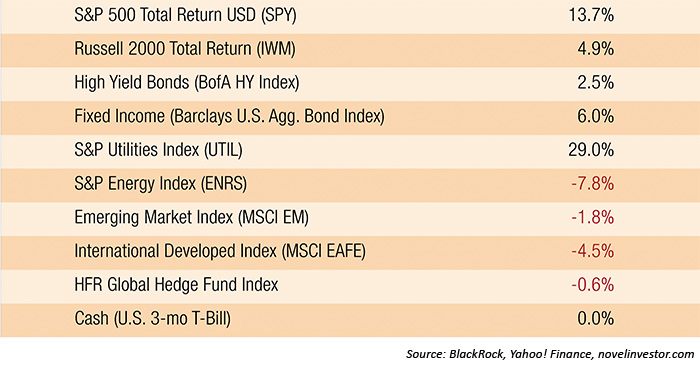Is it time to retire your strategy, manager, fund, or ETF?
Is it time to retire your strategy, manager, fund, or ETF?

There is so much to keep track of these days. There is the crash in oil prices. Terror attacks in Europe. Political drama in Greece. Unexpected decline in interest rates. Inflation expectations. The QE program in Europe. The Fed’s next move. China’s new stock market. The global economy. And, of course, the latest earnings season and expectations for the next one.
I want to take a moment to step back from the news flow and the blinking screens to talk about investing strategy. More specifically, I’d like to talk about the idea of investor expectations.
Many investors (and their advisors) recently assessed how their portfolios performed in 2014 and tried to decide if any adjustments were needed for the new calendar year. But here’s the problem. The vast majority of investors and a great many investment professionals go about this task the wrong way.
What’s your number?
Ask yourself, how do you review the performance of your investments? Is there a certain number you are looking for each year? If so, have you done your homework, and do you know if that number is achievable on a long-term basis? Have you studied up on the historical returns of stocks, bonds, gold, real estate, and so forth?
Or do you compare your returns to the popular indexes such as the S&P 500, the Dow Jones Industrial Average, or the Russell 2000? And if you do, should you be? For example, if you have a diversified portfolio, is it really appropriate to compare your holdings in stocks, bonds, commodities, emerging markets, and so on, to a single index?
So, if you have a diversified portfolio, do you create a blended benchmark for the portfolio that represents the target allocations within your actual holdings? If not, you may want to consider doing so.

Let’s talk stock market returns
The point is that there is more to analyzing a portfolio’s return than simply looking at the S&P 500. For folks investing specifically in the stock market, comparing results to the S&P 500 is a good place to start. However, it is most definitely not the be-all and end-all number.
For example, if you hold mutual funds, do you know the specific goal/strategy of the fund? Do you know where the fund fits within the “style box” universe? And perhaps, more importantly, do you know how the benchmark for that specific style box performed last year? To be fair in your assessment of performance, you really ought to know the style and the objective of the fund/ETF/strategy you are using and then compare accordingly.
Last year was a good example of this point. The S&P 500 wound up with a gain of 11.39% (and over 13% in total return). As such, most investors believe it was a strong year for the overall stock market. However, this was definitely not the case. While the S&P 500 put up a double-digit return, the “generals” of the market—represented by the DJIA—gained just 7.52%. And then the small caps, where so many growth-oriented investors are focused, returned 3.69% (4.9% total return). So, as you can see, not all stocks were created equal in 2014.
And this dichotomy got worse the further away from a passive S&P strategy one strayed.
2014 return performance for various asset classes and sectors

A difficult environment for some
By now you’ve probably seen the headlines that 2014 was not a good year for active managers. For example, hedge funds had one of their weakest years on record. The HFR Equity Hedge Index saw a return of 2.26% last year. And the HFR Global Hedge Fund Index was down 0.6% in 2014.
In addition, some very big names in the active space got spanked last year. One firm, which manages in excess of $5 billion, saw their flagship strategy fall more than 20.5% during the 2014 calendar year.
Next, according to a report from Bank of America Merrill Lynch, a measurement of the alpha (the risk-adjusted return above the overall stock market’s return) in the market hit the lowest level in more than 30 years last year.
The point here is that the S&P 500’s return didn’t really tell the story of how the year went for those active managers attempting to manage risk and create some alpha.
What’s an investor to do?
So, what do you do if your portfolio underperformed the S&P 500? Fire the manager? Quit the strategy? Move into a different fund/ETF? Write a nasty note telling the manager how disappointed you are?
The next point might be tough to take for some. You see, there is no such thing as a silver bullet in this business. Sorry, but there is not a “Holy Grail” fund/manager/ETF/strategy that wins year in and year out.
And yet, this is what a lot of investors think they should be receiving from their funds/advisors.
There is a price for admission …
Here’s the really big point: If you are implementing a strategy that attempts to do much of anything other than buy and hold the S&P 500 (for example, trying to avoid the nastiness that occurs in bear market environments and outperform the S&P over time) you need to understand that there will be times when you have to pay the price of admission for such aspirations.
There will be times when things just don’t go your way. There will be times when you are frustrated or disappointed. If you want to have your cake and eat it too in this game, you need to understand that there will be bumps in the road. And this is what I deem the real secret to long-term investing success—understanding the game and having the proper expectations. The bottom line is that all investment approaches/strategies/styles underperform from time to time—even those of Warren Buffett, the man perceived as the greatest investor of his generation.
What do you do if your portfolio underperformed the S&P 500?
With that said, does it still make sense to compare everything to the S&P 500 or to that number in your head? Wouldn’t it make more sense to actually compare apples to apples—to compare what you are trying to accomplish to an appropriate benchmark?
So, before you send that scathing email to your financial advisor for underperforming the S&P 500 last year, you may want to do some homework. Be sure to first identify what your overall objective was. And then determine how other strategies similar to yours performed.
If your portfolio lost 20% when most others in the class produced returns within a couple percent of breakeven, then by all means, fire that manager or quit that strategy.
However, if you were planning to fire the manager/fund/ETF/strategy because it failed to outperform the S&P 500 last year—while the return was within the norm of returns for the style utilized—you may want to give that decision a second thought.
This article was first published at StateoftheMarkets.com, January 13, 2015.
The opinions expressed in this article are those of the author and do not necessarily represent the views of Proactive Advisor Magazine. These opinions are presented for educational purposes only.
 David D. Moenning is chief investment officer at Sowell Management Services, an independent RIA firm focused on modern portfolio diversification. Mr. Moenning has been a full-time money manager since 1987 and is also the founder of Heritage Capital Research. Mr. Moenning is a former president and chairman of the National Association of Active Investment Managers (NAAIM). heritagecapitalresearch.com
David D. Moenning is chief investment officer at Sowell Management Services, an independent RIA firm focused on modern portfolio diversification. Mr. Moenning has been a full-time money manager since 1987 and is also the founder of Heritage Capital Research. Mr. Moenning is a former president and chairman of the National Association of Active Investment Managers (NAAIM). heritagecapitalresearch.com
